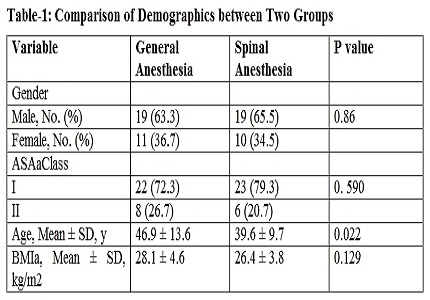Spinal versus general anaesthesia in percutaneous nephrolithotomy
Abstract
Background: Hemodynamic stability and blood loss reduction are subjects to further consideration in patients undergoing percutaneous nephrolithotomy (PNCL).
Objectives: This study compared the preference of spinal anaesthesia (SA) or general anaesthesia (GA) in respect to mentioned concerns.
Methods: In this randomized clinical trial, 59 patients who underwent PCNL divided into SA and GA groups. 15-20 mg from intra-thecal bupivacaine 0.5%, and premedication of 0.01-0.02 mg from midazolam, were given to patients in SA group (n = 29). Patients in GA group (n = 30) received premedication of 1-2 μg/kg from fentanyl and 0.01-0.02 mg/kg from midazolam, and intravenously anaesthetized with 100 μg/kg/min of propofol and 0.5 mg/kg of atracurium, given by continuous infusion and N2O/O2 50%. Mean arterial pressure (MAP) and heart rate were recorded intra-operatively and during recovery.
Results: MAP and heart rate show no significant differences at designated time points between two groups (P > 0.05). Surgery time, anesthesia time, bleeding volume, and analgesic intake were significantly reduced in SA group (P < 0.05).
Conclusions: Regional epidural anaesthesia is an alternative technique for PCNL which achieves more patient satisfaction, less early postoperative pain and less adverse effects from medication with the same efficacy and safety compared to general anaesthesia. It seems that, in patients undergoing PNCL, SA is as effective and safe as GA and with many advantages over it.
Downloads
References
Stening SG, Bourne S: Supracostal percutaneous nephrolithotomy for upper pole caliceal calculi. J Endourol.1998; 12: 359-62.
Lojanapiwat B, Prasopsuk S: Upper-pole access for percutaneous nephrolithotomy: comparison of supracostal and infracostal approaches. J Endourol. 2006 ; 20 :491-4.
Jun-Ou J, Lojanapiwat B: Supracostal access: does it affect tubeless percutaneous nephrolithotomy efficacy and safety? Int Braz J Urol. 2010; 36: 171-6.
Kuzgunbay B, Turunc T, Akin S, Ergenoglu P, Aribogan A, Ozkardes H: Percutaneous nephrolithotomy under general versus combined spinal-epidural anesthesia. J Endourol. 2009 Nov;23(11):1835-8. doi: https://doi.org/10.1089/end.2009.0261.
Karacalar S, Bilen CY, Sarihasan B, Sarikaya S: Spinal-epidural anesthesia versus general anesthesia in the management of percutaneous nephrolithotripsy. J Endourol. 2009 Oct;23(10):1591-7. doi: https://doi.org/10.1089/end.2009.0224.
Singh V, Sinha RJ, Sankhwar SN, Malik A: A prospective randomized study comparing percutaneous nephrolithotomy under combined spinal-epidural anesthesia with percutaneous nephrolithotomy under general anesthesia. Urol Int. 2011;87(3):293-8. doi: https://doi.org/10.1159/000329796. Epub 2011 Sep 14.
Urwin SC, Parker MJ, Griffiths R. General versus regional anaes¬thesia for hip fracture surgery: a meta-analysis of randomized trials. Br J Anaesth. 2000;8 4 (4) : 450-5.
Indelli PF, Grant SA, Nielsen K, Vail TP. Regional anesthesia in hip surgery. Clin Orthop Relat Res. 2005 : 441: 250-5.
Sakura S. [Epidural anesthesia and spinal anesthesia in the el¬derly]. Masui 2007: 56(2):130-8.
Ditzler JW, Dumke PR, Harrington JJ, Fox JD. Should spinal an¬esthesia be used in surgery for herniated intervertebral disk. Anesth Analg. 1959;38(2):118-24.
Bellman GC, Davidoff R, Candela J, Gerspach J, Kurtz S, Stout L: Tubeless percutaneous renal surgery. J Urol. 1997 May;157(5):1578-82.
Salonia A, Suardi N, Crescenti A, Colombo R, Rigatti P, Montorsi F: General versus spinal anesthesia with different forms of sedation in patients undergoing radical retropubic prostatectomy: results of a prospective, randomized study. Int J Urol. 2006 Sep;13(9):1185-90.
Maurer SG, Chen AL, Hiebert R, Pereira GC, Di Cesare PE: Comparison of outcomes of using spinal versus general anesthesia in total hip arthroplasty. Am J Orthop (Belle Mead NJ). 2007 Jul;36(7):E101-6.
Rozentsveig V, Neulander EZ, Roussabrov E, Schwartz A, Lismer L, Gurevich B, et al. Anesthetic considerations during percutane¬ous nephrolithotomy. J Clin Anesth. 2007;19(5):351-5.
Covino BG. Rationale for spinal anesthesia. Int Anesthesiol Clin. 1989; 27(1) :8-12.
Davis S, Erskine R, James MF. A comparison of spinal and epidural anaesthesia for hip arthroplasty. Can J Anaesth. 1992;39(6):551-4.
Guedj P, Eldor J, Gozal Y. [Comparative study of conventional spinal anesthesia and combined spinal-epidural anesthesia in gynecological surgery]. Ann Fr Anesth Reanim. 1992;11(4) :399-404.
Holmstrom B, Laugaland K, Rawal N, Hallberg S. Combined spi¬nal epidural block versus spinal and epidural block for ortho¬paedic surgery. Can J Anaesth. 1993;40(7):601-6.
Niemi TT, Pitkanen M, Syrjala M, Rosenberg PH. Comparison of hypotensive epidural anaesthesia and spinal anaesthesia on blood loss and coagulation during and after total hip arthro¬plasty. Acta Anaesthesiol Scand. 2000;44(4):457-64.
Seeberger MD, Lang ML, Drewe J, Schneider M, Hauser E, Hruby J. Comparison of spinal and epidural anesthesia for patients younger than 50 years of age. Anesth Analg.1994;78(4):667-73.
Stober HD, Mencke T. [General anesthesia or spinal anesthesia for hip prosthesis replacement? Studies of acceptance of both procedures by patients]. Anaesthesiol Reanim 1999;24(6):151-6.
Sutter PA, Gamulin Z, Forster A. Comparison of continuous spinal and continuous epidural anaesthesia for lower limb surgery in elderly patients. A retrospective study. Anaesthesia.1989;44(1):47-50.
Kehlet H. The stress response to surgery: release mechanisms and the modifying effect of pain relief. Acta Chir Scand Suppl. 1989;550:22-8.
McLain RF, Kalfas I, Bell GR, Tetzlaff JE, Yoon HJ, Rana M. Compari¬son of spinal and general anesthesia in lumbar laminectomy surgery: a case-controlled analysis of 400 patients. J Neurosurg Spine. 2005;2(1):17-22.
Ebneshahidi A, Mohseni M. Premedication with oral clonidine decreases intraoperative bleeding and provides hemodynamic stability in cesarean section. Anesth Pain. 2011:1(1):30-3.
Tetzlaff JE, Dilger JA, Kodsy M, al-Bataineh J, Yoon HJ, Bell GR. Spi¬nal anesthesia for elective lumbar spine surgery. J Clin Anesth. 1998;10(8):666-9.



 OAI - Open Archives Initiative
OAI - Open Archives Initiative


